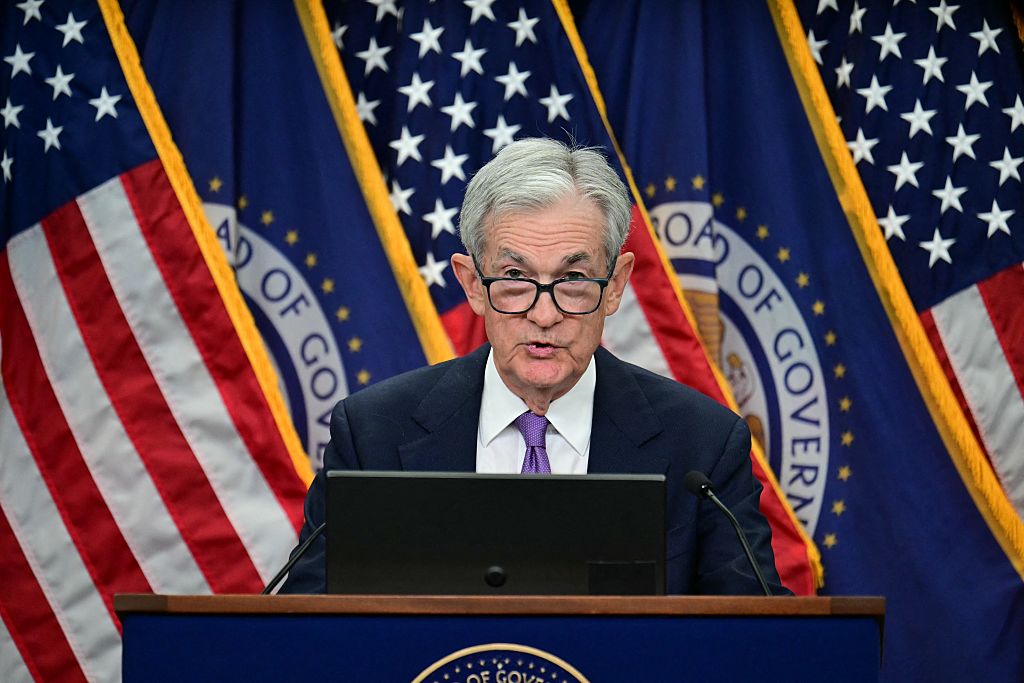GDP Jumps 2.6% in Q3. Experts Say the Economy Is Still Losing Steam
Experts say consumers are still spending, but inflation and jobs look less rosy.


GDP rebounded in the third quarter after two consecutive quarters of contraction, but experts say the rosy headline figure hides grim facts about the actual state of U.S. economic health.
The first of what will eventually be three readings of Q3 gross domestic product showed that the economy expanded at an annual rate of 2.6% in the July to September period, the Commerce Department said Thursday. That preliminary estimate topped projections for annualized growth of 2.4%.
Although the report revealed resilience on the part of American consumers and businesses, personal consumption – the largest share of the economy – expanded at 1.4% pace. That was better than economists' average estimate but still represented a slowdown from the previous quarter.
From just $107.88 $24.99 for Kiplinger Personal Finance
Become a smarter, better informed investor. Subscribe from just $107.88 $24.99, plus get up to 4 Special Issues

Sign up for Kiplinger’s Free Newsletters
Profit and prosper with the best of expert advice on investing, taxes, retirement, personal finance and more - straight to your e-mail.
Profit and prosper with the best of expert advice - straight to your e-mail.
GDP figures are subject to revision and can change significantly between initial estimates and final readings. It's also true that the headline number can present a distorted picture of what's actually going on under the hood.
To get a sense of what the experts make of the latest GDP report, below please find a selection of commentary (sometimes edited for clarity and brevity) from economists, market strategists and other financial professionals.
What the experts say:
"Real GDP was slightly better than expected in the third quarter. Consumers increased spending on services, and businesses spent more on equipment and intellectual property. A smaller trade deficit was a boost to GDP, too. Consumer spending on food, energy and autos fell, and construction spending on residential and nonresidential structures were headwinds. Businesses also added less to inventories in the third quarter. While GDP was a little better than expected, the underlying trend of economic activity continues to slow. In addition, continued jobless claims rose quite a bit in mid-October, a sign that workers who lose jobs are having more trouble finding new employment. The economy will likely cool further in the near-term." – Bill Adams, chief economist at Comerica Bank
"The U.S. economy has continued to weaken but, once again, the topline GDP number is hiding some of this weakness. In the first quarter, net exports brought down GDP growth, contributing -3.13% to economic growth. This time around it was net exports that contributed 2.77 percentage points to economic growth as exports of goods surged during the quarter even as the U.S. dollar remained strong. The Federal Reserve should look at this report with caution and remain mindful of the underlying trend for US economic growth, which shows a weakening economy." – Eugenio Alemán, Chief Economist at Raymond James
"U.S. real GDP growth came in at +2.6% at an annual rate, and that modestly beat the +2.4% consensus estimate and interrupted the prior two quarters of contraction. This is either just a blip in a recession that started with the food and fuel inflation shock at the turn of the year, or we are set for a double-dip as the lagged impact of the Fed’s aggressive policy tightening percolates through with the classic lags." – David Rosenberg, founder and president of Rosenberg Research
"The headline growth rate was flattered by the 2.8 percentage point boost from real net exports. However, imports likely will rebound and exports look set to weaken given clear signs of economic deceleration abroad and the strength of the dollar. Real final sales to domestic purchases, which is the sum of consumer spending and fixed investment spending, was essentially flat in the third quarter. We look for the FOMC to hike rates by another 75 bps at its meeting on November 2. We also expect the U.S. economy to slip into recession starting in the second quarter of 2023." – Jay Bryson, Chief Economist at Wells Fargo Securities
"U.S. real GDP rebounded late summer but that doesn't mean the economy strengthened; in fact, its underlying resilience is fraying in response to aggressive rate hikes and high inflation. Basically, the private domestic economy has stalled and looks to repeat this performance in the current quarter before contracting early next year. Despite the shiny headline number, a look under the hood shows a much grimmer picture of the U.S. economy, one that is clearly losing steam. With the full effect of past and future Fed rate hikes still to be felt, the economy appears poised for a modest downturn in the first half of next year." – Sal Guatieri, senior economist at BMO Capital Markets
"The third quarter GDP report showed that the economy grew at an annualized rate of 2.6 percent during the quarter following a 0.6 percent decline in the second quarter. This better than expected result was driven by improvements for international trade, as exports surged during the period while imports slowed. The underlying data was a bit more mixed however, as personal consumption growth slowed during the quarter, in a sign that inflation took a toll on consumer spending. Despite the slowdown in inflationary pressure during the quarter, the report should support the Fed’s plans for an additional 75 basis point hike at their November meeting." – Sam Millette, fixed income strategist at Commonwealth Financial Network
"The U.S. is not currently in recession, given the strength of the consumer sector. However, excluding the more volatile categories, the trajectory for growth looks weak. A deteriorating housing market and nagging inflation along with an aggressive Federal Reserve puts the economy on unsure footing for 2023. A silver lining is markets have possibly priced in much of the near-term recession risks." – Jeffrey Roach, chief economist at LPL Financial
Profit and prosper with the best of Kiplinger's advice on investing, taxes, retirement, personal finance and much more. Delivered daily. Enter your email in the box and click Sign Me Up.

Dan Burrows is Kiplinger's senior investing writer, having joined the publication full time in 2016.
A long-time financial journalist, Dan is a veteran of MarketWatch, CBS MoneyWatch, SmartMoney, InvestorPlace, DailyFinance and other tier 1 national publications. He has written for The Wall Street Journal, Bloomberg and Consumer Reports and his stories have appeared in the New York Daily News, the San Jose Mercury News and Investor's Business Daily, among many other outlets. As a senior writer at AOL's DailyFinance, Dan reported market news from the floor of the New York Stock Exchange.
Once upon a time – before his days as a financial reporter and assistant financial editor at legendary fashion trade paper Women's Wear Daily – Dan worked for Spy magazine, scribbled away at Time Inc. and contributed to Maxim magazine back when lad mags were a thing. He's also written for Esquire magazine's Dubious Achievements Awards.
In his current role at Kiplinger, Dan writes about markets and macroeconomics.
Dan holds a bachelor's degree from Oberlin College and a master's degree from Columbia University.
Disclosure: Dan does not trade individual stocks or securities. He is eternally long the U.S equity market, primarily through tax-advantaged accounts.
-
 'Donroe Doctrine' Pumps Dow 594 Points: Stock Market Today
'Donroe Doctrine' Pumps Dow 594 Points: Stock Market TodayThe S&P 500 rallied but failed to turn the "Santa Claus Rally" indicator positive for 2026.
-
 The Wealth Equation: Balancing Money and Stress
The Wealth Equation: Balancing Money and StressSponsored Don’t let assets be a liability that strains your family.
-
 Is Your Emergency Fund Running Low? Here's How to Bulk It Up
Is Your Emergency Fund Running Low? Here's How to Bulk It UpIf you're struggling right now, you're not alone. Here's how you can identify financial issues, implement a budget and prioritize rebuilding your emergency fund.
-
 The November CPI Report Is Out. Here's What It Means for Rising Prices
The November CPI Report Is Out. Here's What It Means for Rising PricesThe November CPI report came in lighter than expected, but the delayed data give an incomplete picture of inflation, say economists.
-
 The Delayed November Jobs Report Is Out. Here's What It Means for the Fed and Rate Cuts
The Delayed November Jobs Report Is Out. Here's What It Means for the Fed and Rate CutsThe November jobs report came in higher than expected, although it still shows plenty of signs of weakness in the labor market.
-
 December Fed Meeting: Updates and Commentary
December Fed Meeting: Updates and CommentaryThe December Fed meeting is one of the last key economic events of 2025, with Wall Street closely watching what Chair Powell & Co. will do about interest rates.
-
 The Delayed September Jobs Report Is Out. Here's What It Means for the Fed
The Delayed September Jobs Report Is Out. Here's What It Means for the FedThe September jobs report came in much higher than expected, lowering expectations for a December rate cut.
-
 October Fed Meeting: Updates and Commentary
October Fed Meeting: Updates and CommentaryThe October Fed meeting is a key economic event, with Wall Street turned into what Fed Chair Powell & Co. did about interest rates.
-
 The Delayed September CPI Report is Out. Here's What it Signals for the Fed.
The Delayed September CPI Report is Out. Here's What it Signals for the Fed.The September CPI report showed that inflation remains tame – and all but confirms another rate cut from the Fed.
-
 Banks Are Sounding the Alarm About Stablecoins
Banks Are Sounding the Alarm About StablecoinsThe Kiplinger Letter The banking industry says stablecoins could have a negative impact on lending.
-
 Government Shutdown to Delay Data, Including Key Jobs Report
Government Shutdown to Delay Data, Including Key Jobs ReportWhile government shutdowns typically don't impact stock returns, they can delay the release of key economic data – including the monthly jobs report.